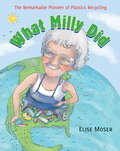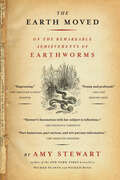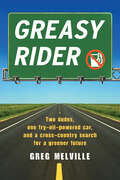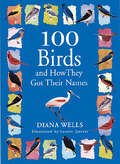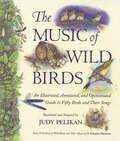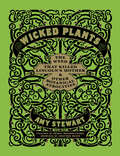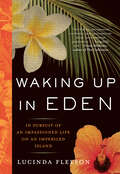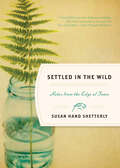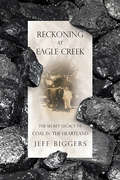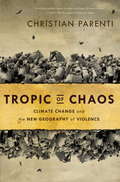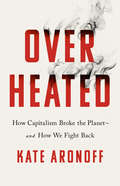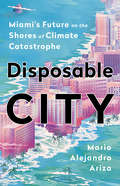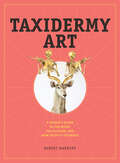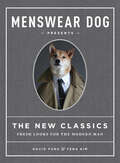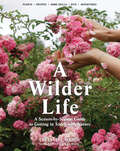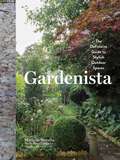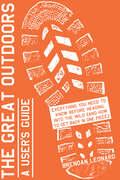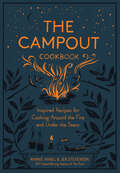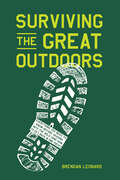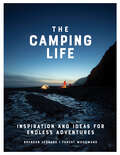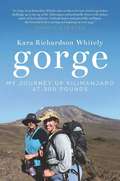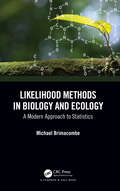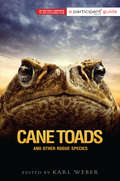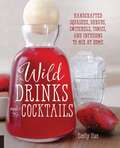- Table View
- List View
What Milly Did: The Remarkable Pioneer of Plastics Recycling
by Elise MoserThe extraordinary story of the woman who made plastics recycling possible. Milly Zantow wanted to solve the problem of her town’s full landfill and ended up creating a global recycling standard — the system of numbers you see inside the little triangle on plastics. This is the inspiring story of how she mobilized her community, creating sweeping change to help the environment. On a trip to Japan in 1978, Milly noticed that people were putting little bundles out on the street each morning. They were recycling — something that hadn’t taken hold in North America. When she returned to Sauk City, Wisconsin, she discovered that her town’s landfill was nearing capacity, and that plastic made up a large part of the garbage. No one was recycling plastics. Milly decided to figure out how. She discovered that there are more than seven kinds of plastic, and they can’t be combined for recycling, so she learned how to use various tests to identify them. Then she found a company willing to use recycled plastic, but the plastic would have to be ground up first. Milly and her friend bought a huge industrial grinder and established E-Z Recycling. They worked with local school children and their community, and they helped other communities start their own recycling programs. But Milly knew that the large-scale recycling of plastics would never work unless people could easily identify the seven types. She came up with the idea of placing an identifying number in the little recycling triangle, which has become the international standard. Milly's story is a glimpse into the early days of the recycling movement and shows how, thanks to her determination, hard work and community-building, huge changes took place, spreading rapidly across North America. Correlates to the Common Core State Standards in English Language Arts: CCSS.ELA-LITERACY.RI.3.3 Describe the relationship between a series of historical events, scientific ideas or concepts, or steps in technical procedures in a text, using language that pertains to time, sequence, and cause/effect. CCSS.ELA-LITERACY.RI.4.7 Interpret information presented visually, orally, or quantitatively (e.g., in charts, graphs, diagrams, time lines, animations, or interactive elements on Web pages) and explain how the information contributes to an understanding of the text in which it appears.
The Earth Moved: On the Remarkable Achievements of Earthworms
by Amy Stewart"You know a book is good when you actually welcome one of those howling days of wind and sleet that makes going out next to impossible." —The New York Times In The Earth Moved, Amy Stewart takes us on a journey through the underground world and introduces us to one of its most amazing denizens. The earthworm may be small, spineless, and blind, but its impact on the ecosystem is profound. It ploughs the soil, fights plant diseases, cleans up pollution, and turns ordinary dirt into fertile land. Who knew? In her witty, offbeat style, Stewart shows that much depends on the actions of the lowly worm. Charles Darwin devoted his last years to the meticulous study of these creatures, praising their remarkable abilities. With the august scientist as her inspiration, Stewart investigates the worm's subterranean realm, talks to oligochaetologists—the unsung heroes of earthworm science—who have devoted their lives to unearthing the complex life beneath our feet, and observes the thousands of worms in her own garden. From the legendary giant Australian worm that stretches to ten feet in length to the modest nightcrawler that wormed its way into the heart of Darwin's last book to the energetic red wigglers in Stewart's compost bin, The Earth Moved gives worms their due and exposes their hidden and extraordinary universe. This book is for all of us who appreciate Mother Nature's creatures, no matter how humble.
Greasy Rider: Two Dudes, One Fry-Oil-Powered Car, and a Cross-Country Search for a Greener Future
by Greg MelvilleIs it possible to drive coast-to-coast without stopping at a single gas pump? Journalist Greg Melville is determined to try. With his college buddy Iggy riding shotgun, this green-thinking guy—who's in love with the idea of free fuel—sets out on an enlightening road trip. The quest: to be the first people to drive cross-country in a french-fry car. Will they make it from Vermont to California in a beat-up 1985 Mercedes diesel station wagon powered on vegetable oil collected from restaurant grease Dumpsters along the way? More important, can two guys survive 192 consecutive hours together? Their expedition on and off the road includes visits to the solar-powered Google headquarters; the National Ethanol Council; the wind turbines of southwestern Minnesota; the National Renewable Energy Lab; a visit to one of the first houses to receive platinum certification for leadership in Energy and Environmental Design (LEED); an "eco-friendly" Wal-Mart; and the world's largest geothermal heating system. Part adventure and part investigation of what we're doing (or not doing) to preserve the planet, Greasy Rider is upbeat, funny, and full of surprising information about sustainable measures that are within our reach.
100 Birds and How They Got Their Names
by Diana WellsHow did cranes come to symbolize matrimonial happiness? Why were magpies the only creatures that would not go inside Noah's Ark? Birds and bird imagery are integral parts of our language and culture. With her remarkable ability to dig up curious and captivating facts, Diana Wells hatches a treat for active birders and armchair enthusiasts alike. Meet the intrepid adventurers and naturalists who risked their lives to describe and name new birds. Learn the mythical stories of the gods and goddess associated with bird names. Explore the avian emblems used by our greatest writers--from Coleridge's albatross in "The Ancient Mariner" to Poe's raven. A sampling of the bird lore you'll find inside: Benjamin Franklin didn't want the bald eagle on our National Seal because of its "bad moral character," (it steals from other birds); he lobbied for the turkey instead. Chaffinches, whose Latin name means "unmarried," are called "bachelor birds" because they congregate in flocks of one gender. Since mockingbirds mimic speech, some Native American tribes fed mockingbird hearts to their children, believing it helped them learn language. A group of starlings is called a murmuration because they chatter so when they roost in the thousands. Organized alphabetically, each of these bird tales is accompanied by a two-color line drawing. Dip into 100 Birds and you'll never look at a sparrow, an ostrich, or a wren in quite the same way.
The Music of Wild Birds: An Illustrated, Annotated, and Opinionated Guide to Fifty Birds and Their Songs
by Judy PelikanOne hundred years ago, F. Schuyler Mathews, an erudite naturalist and birder, theorized that birds sing first for love of music, and second for love of the lady. To expand on his theory, he actually scored the songs of birds in the wild. His charming text and bird-by-bird annotations were compiled into a guide called Field Book of Wild Birds and Their Music. This extraordinary work has now been lavishly illustrated and adapted for a new audience. Each bird is meticulously rendered by artist Judy Pelikan in full-color illustrations that feature not only the birds, but also their nests, eggs, and feathers. And every song is represented by its written musical score, which Mathews expertly explains in a way that both musicians and non-musicians can enjoy. As Mathews points out, the music of wild birds is everywhere--in poems, children's nursery songs, as well as in the works of the great composers: the Black-billed Cuckoo's call appears near the close of Beethoven's Pastoral Symphony; the Nashville Warbler's song is found in the opening bars of Rossini's Carovale, and the Meadowlark's song is remarkably like the first two bars of Alfredo's song in La Traviata. He reveals how a bird's character is reflected in its song: the Baltimore Oriole is a sharp-billed, sharp-witted character, and his remarks are as incisive and crisp as the toots of a steam whistle. And he reminds us of the words of our great poets--Wordsworth, Emerson, Sir Walter Scott--and their descriptions of the very same birds and their music. This classic, useful, and completely original guide will put a song into the heart of novice and experienced birder alike.
Wicked Plants: The Weed That Killed Lincoln's Mother and Other Botanical Atrocities
by Amy StewartA tree that sheds poison daggers; a glistening red seed that stops the heart; a shrub that causes paralysis; a vine that strangles; and a leaf that triggered a war. In Wicked Plants, Stewart takes on over two hundred of Mother Nature’s most appalling creations. It’s an A to Z of plants that kill, maim, intoxicate, and otherwise offend. You’ll learn which plants to avoid (like exploding shrubs), which plants make themselves exceedingly unwelcome (like the vine that ate the South), and which ones have been killing for centuries (like the weed that killed Abraham Lincoln's mother). Menacing botanical illustrations and splendidly ghastly drawings create a fascinating portrait of the evildoers that may be lurking in your own backyard. Drawing on history, medicine, science, and legend, this compendium of bloodcurdling botany will entertain, alarm, and enlighten even the most intrepid gardeners and nature lovers.
Waking Up in Eden: In Pursuit of an Impassioned Life on an Imperiled Island
by Lucinda FleesonLike so many of us, Lucinda Fleeson wanted to escape what had become a routine life. So, she quit her big-city job, sold her suburban house, and moved halfway across the world to the island of Kauai to work at the National Tropical Botanical Garden. Imagine a one-hundred-acre garden estate nestled amid ocean cliffs, rain forests, and secluded coves. Exotic and beautiful, yes, but as Fleeson awakens to this sensual world, exploring the island's food, beaches, and history, she encounters an endangered paradise—the Hawaii we don't see in the tourist brochures. Native plants are dying at an astonishing rate—Hawaii is called the Extinction Capital of the World—and invasive species (plants, animals, and humans) have imperiled this Garden of Eden. Fleeson accompanies a plant hunter into the rain forest to find the last of a dying species, descends into limestone caves with a paleontologist who deconstructs island history through fossil life, and shadows a botanical pioneer who propagates rare seeds, hoping to reclaim the landscape. Her grown-up adventure is a reminder of the value of choosing passion over security, individuality over convention, and the pressing need to protect the earth. And as she witnesses the island's plant renewal efforts, she sees her own life blossom again.
Settled in the Wild: Notes from the Edge of Town
by Susan Hand ShetterlyWhether we live in cities, suburbs, or villages, we are encroaching on nature, and it in one way or another perseveres. Naturalist Susan Shetterly looks at how animals, humans, and plants share the land—observing her own neighborhood in rural Maine. She tells tales of the locals (humans, yes, but also snowshoe hares, raccoons, bobcats, turtles, salmon, ravens, hummingbirds, cormorants, sandpipers, and spring peepers). She expertly shows us how they all make their way in an ever-changing habitat. In writing about a displaced garter snake, witnessing the paving of a beloved dirt road, trapping a cricket with her young son, rescuing a fledgling raven, or the town's joy at the return of the alewife migration, Shetterly issues warnings even as she pays tribute to the resilience that abounds. Like the works of Annie Dillard and Aldo Leopold, Settled in the Wild takes a magnifying glass to the wildness that surrounds us. With keen perception and wit, Shetterly offers us an education in nature, one that should inspire us to preserve it.
Reckoning at Eagle Creek: The Secret Legacy of Coal in the Heartland
by Jeff BiggersCultural historian Jeff Biggers takes us to the dark amphitheatre ruins of his family's nearly 200-year-old hillside homestead that has been strip-mined on the edge of the first federally recognized Wilderness Site in southern Illinois. In doing so, he not only comes to grips with his own denied backwoods heritage, but also chronicles a dark and missing chapter in the American experience: the historical nightmare of coal outside of Appalachia, serving as an exposé of a secret legacy of shame and resiliency.
Tropic of Chaos: Climate Change and the New Geography of Violence
by Christian ParentiFrom Africa to Asia and Latin America, the era of climate wars has begun. Extreme weather is breeding banditry, humanitarian crisis, and state failure. In Tropic of Chaos, investigative journalist Christian Parenti travels along the front lines of this gathering catastrophe--the belt of economically and politically battered postcolonial nations and war zones girding the planet's midlatitudes. Here he finds failed states amid climatic disasters. But he also reveals the unsettling presence of Western military forces and explains how they see an opportunity in the crisis to prepare for open-ended global counterinsurgency. Parenti argues that this incipient "climate fascism"--a political hardening of wealthy states-- is bound to fail. The struggling states of the developing world cannot be allowed to collapse, as they will take other nations down as well. Instead, we must work to meet the challenge of climate-driven violence with a very different set of sustainable economic and development policies.
Overheated: How Capitalism Broke the Planet--And How We Fight Back
by Kate AronoffThis damning account of the forces that have hijacked progress on climate change shares a bold vision of what it will take, politically and economically, to face the existential threat of global warming head-on.In the past few years, it has become impossible (for most) to deny the effects of climate change and that the planet is warming, and to acknowledge that we must act. But a new kind of denialism is taking root in the halls of power, shaped by a quarter-century of neoliberal policies, that threatens to doom us before we've grasped the full extent of the crisis.As Kate Aronoff argues, since the 1980s and 1990s, economists, pro-business Democrats and Republicans in the US, and global organizations like the UN and the World Economic Forum have all made concessions to the oil and gas industry that they have no intention of reversing. What's more, they believe that climate change can be solved through the market, capitalism can be a force for good, and all of us, corporations included, are fighting the good fight together.These assumptions, Aronoff makes abundantly clear, will not save the planet. Drawing on years of reporting and rigorous economic analysis, Aronoff lays out a robust vision for what will, detailing how to constrain the fossil fuel industry; transform the economy into a sustainable, democratic one; mobilize political support; create effective public-private partnerships; enact climate reparations; and adapt to inevitable warming in a way that is just and equitable.Our future, Overheated makes clear, will require a radical reimagining of our politics and our economies, but if done right, it will save the world.
Disposable City: Miami's Future on the Shores of Climate Catastrophe
by Mario Alejandro ArizaA deeply-reported personal investigation by a Miami journalist into the present and future effects of climate change in the Magic City-a watery harbinger for coastal cities worldwide.Miami, Florida, is likely to be entirely underwater by the end of this century. Residents are already starting to see the effects of sea level rise today. From sunny day flooding caused by higher tides to a sewer system on the brink of total collapse, the city undeniably lives in a climate changed world. In Disposable City, Miami resident Mario Alejandro Ariza shows us not only what climate change looks like on the ground today, but also what Miami will look like 100 years from now, and how that future has been shaped by the city's racist past and present. As politicians continue to kick the can down the road and Miami becomes increasingly unlivable, real estate vultures and wealthy residents will be able to get out or move to higher ground, but the most vulnerable communities, disproportionately composed of people of color, will face flood damage, rising housing costs, dangerously higher temperatures, and stronger hurricanes that they can't afford to escape. Miami may be on the front lines of climate change, but the battle it's fighting today is coming for the rest of the U.S.--and the rest of the world--far sooner than we could have imagined even a decade ago. Disposable City is a thoughtful portrait of both a vibrant city with a unique culture and the social, economic, and psychic costs of climate change that call us to act before it's too late.
Taxidermy Art: A Rogue's Guide to the Work, the Culture, and How to Do It Yourself
by Robert MarburyIn this collection of taxidermy art, you’ll find a winged monkey with a fez and a martini glass, a jewel-encrusted piglet, a bionic fawn, and a polar bear balancing on a floating refrigerator. Author Robert Marbury makes for a friendly (and often funny) guide, addressing the three big questions people have about taxidermy art: What is it all about? Can I see some examples? and How can I make my own? He takes readers through a brief history of taxidermy (and what sets artistic taxidermy apart) and presents stunning pieces from the most influential artists in the field. Rounding out the book are illustrated how-to lessons to get readers started on their own work, with sources for taxidermy materials and resources for the budding taxidermist.
Menswear Dog Presents the New Classics: Fresh Looks for the Modern Man
by David Fung Yena KimBodhi, the Shiba Inu behind the beloved blog Menswear Dog, is here to show you how to dress like a man. Organized seasonally, The New Classics highlights the timeless, can&’t-go-wrong items every man needs in his wardrobe—from a chambray shirt to a perfectly fitted peacoat (all modeled by Bodhi, of course)—and shows how to mix and match them all year long. Whatever your style dilemma, dog&’s got your back! Readers will learn what to wear to a summer wedding, when to splurge (on the perfect white dress shirt) and when to save (snag your military field jacket at a thrift store), the secrets to getting the right fit, the brands that stand the test of time, the basics of clothing care, and more.
A Wilder Life: A Season-by-Season Guide to Getting in Touch with Nature
by Celestine Maddy Abbye ChurchillIn our technology-driven, workaday world, connecting with nature has never before been more essential. A Wilder Life, a beautiful oversized lifestyle book by the team behind the popular Wilder Quarterly, gives readers indispensable ideas for interacting with the great outdoors. Learn to plant a night-blooming garden, navigate by reading the stars, build an outdoor shelter, make dry shampoo, identify insects, cultivate butterflies in a backyard, or tint your clothes with natural dyes. Like a modern-day Whole Earth Catalog, A Wilder Life gives us DIY projects and old-world skills that are being reclaimed by a new generation. Divided into sections pertaining to each season and covering self-reliance, growing and gardening, cooking, health and beauty, and wilderness, and with photos and illustrations evocative of the great outdoors, A Wilder Life shows that getting in touch with nature is possible no matter who you are and—more important—where you are.
Gardenista: The Definitive Guide to Stylish Outdoor Spaces
by Michelle SlatallaNamed a Best Gift Book for Gardeners by The New York Times Book Review, Los Angeles Times, San Francisco Chronicle, Seattle Times, Domino magazine, and Goop. The team behind the inspirational design sites Gardenista.com and Remodelista.com presents an all-in-one manual for making your outdoor space as welcoming as your living room. Tour personality-filled gardens around the world and re-create the looks with no-fail planting palettes. Find hundreds of design tips and easy DIYs, editors&’ picks of 100 classic (and stylish) objects, a landscaping primer with tips from pros, over 200 resources, and so much more.
The Great Outdoors: Everything You Need to Know Before Heading into the Wild (and How to Get Back in One Piece)
by Brendan Leonard&“Leonard&’s durable tome (seriously, the cover is rubber) is stuffed with so many tips about surviving in the wild, you&’ll be able to leave your smartphone behind.&” —Entertainment Weekly, Best New Books This easy introduction to outdoor life will ensure that even a novice won&’t get lost in the woods while finding an activity he loves to do in the great outdoors--whether it&’s hiking a 14er or camping on ice. With 400 strategies for engaging in the outdoors, and expert tips and tricks, The Great Outdoors: A User&’s Guide makes Mother Nature easier to understand than ever before. Brendan Leonard, writer, filmmaker, and outdoor adventurer, shows the reader how rewarding it can be to live life away from the computer and get outside. From mountain climbing, to skiing, sledding, and sailing, Leonard shows that you don&’t need to be a risk taker to enjoy the outdoors. And if the reader does find himself at the point of man vs. nature, Leonard shares survival skills from how to bandage a wound and read a topographical map, to how to drive on sand and remove a tick from your skin—all organized thematically and written in short takeaway entries with helpful line drawings. Bound in a uniquely rugged (and waterproof!) PVC cover material, The Great Outdoors: A User&’s Guide is a friendly way into the outdoor lifestyle, whether you're looking to dabble or go all in.
The Campout Cookbook: Inspired Recipes for Cooking Around the Fire and Under the Stars
by Marnie Hanel Jen Stevenson&“Spells out how to eat well when camping out.&”—The Washington Post &“This is the rare book that considers campfire cookery as a gustatory pursuit.&”—Sierra, the National Magazine of the Sierra Club Forget freeze-dried astronaut meals and bags of stale, store-bought gorp. Finally, here&’s a cookbook that complements the magic of gathering around a campfire and sharing a meal with friends. From the IACP Award–winning authors of The Picnic, which brought taste and style to eating outdoors (in the daytime), comes its companion, for leaving civilization behind and dining under the stars. A mix of dishes to make ahead and meals to cook on-site, The Campout Cookbook includes more than 75 recipes for wood-fired skillet pizzas; backcountry stews and chilies; fire-roasted vegetables and cast-iron breads; unexpected dips, jerkies, and high-energy bars; breakfasts to satisfy that yawning hunger that comes from sleeping in the fresh air; s&’mores, of course (including Vanilla Bean Dream Marshmallows & Co. and Dark Chocolate Raspberry Caramel Fire-Ban S&’mores); and cocktails, coolers, warm libations for chilly nights, and a Blood Orange Bug Juice. Plus there&’s inspiration and know-how for every avid camper and enthusiastic neophyte: How to find a suitable campsite and build a campfire specifically for cooking over, and how to keep it going. Stargazing for city slickers. A troubleshooting guide. And the definitive packing list and camp kitchen essentials. Just add a few scary stories for a truly memorable campout.
Surviving the Great Outdoors: Everything You Need to Know Before Heading into the Wild (and How to Get Back in One Piece)
by Brendan LeonardFrom how to fight off a bear and how to identify poison ivy to how to rappel down a mountain and select the right sleeping bag for cold-weather camping, this intro-level guide teaches the skills that anyone can use to thrive in the great outdoors.
The Camping Life: Inspiration and Ideas for Endless Adventures
by Brendan Leonard Forest WoodwardAn inspirational and captivating camping book with detailed information for how to camp like an expert with both comfort and style.
Gorge: My Journey Up Kilimanjaro at 300 Pounds
by Kara Richardson WhitelyThe inspiring memoir of a plus-size woman who summited Kilimanjaro while overcoming fat prejudice and her own demons--"I was moved and inspired by every page of this beautiful book" (Cheryl Strayed)Kara Richardson Whitely was determined to reach the summit of Mt. Kilimanjaro. But she struggled with each step--with the grueling conditions on the steep mountainside, with the 300-pound weight of her own body, and with her food addiction, which came from a lifetime of reckoning with feelings of failure and shame. Deep in her personal gorge, Kara realized the only way out was up. Gorge: My Journey Up Kilimanjaro at 300 Pounds is the raw story of Kara's ascent from the depths of self-doubt to the top of the world. Her inspiring trek speaks to every woman who has struggled with her self-image or felt that food was controlling her life. Honest and unforgettable, Kara's journey is one of intense passion, endurance, and self-acceptance.
Likelihood Methods in Biology and Ecology: A Modern Approach to Statistics
by Michael BrimacombeThis book emphasizes the importance of the likelihood function in statistical theory and applications and discusses it in the context of biology and ecology. Bayesian and frequentist methods both use the likelihood function and provide differing but related insights. This is examined here both through review of basic methodology and also the integr
Cane Toads and Other Rogue Species: Participant Second Book Project
by Participant Productions edited by Karl WeberWhat does an unusually large, ugly, invasive species of toad have to do with global warming, international trade, and the survival of biodiversity? Quite a lot, actually. Mark Lewis's amazing and hilarious documentary Cane Toads tells the story of Bufo marinus, which was introduced to Australia in 1935 to control bugs but which quickly became a far greater menace than the beetles they eat. Today they number in the hundreds of millions and are taking over Australian habitats at 25 miles per year, spreading disease and killing native species as they go.Rogue Species explains the little-understood dangers of invasive species. Ranging from the zebra mussel (currently threatening the health of the Great Lakes) to the infamous kudzu vine (a Japanese import that now smothers seven million acres in the American southeast), these disastrous human blunders threaten the biodiversity on which all life-including our own-depends. The book will raise readers' awareness about the threat of non-native species, increase their appreciation of natural biodiversity, and explain what they can do to help protect unique ecosystems wherever they live or travel.
Wild Drinks And Cocktails: Handcrafted Squashes, Shrubs, Switchels, Tonics, And Infusions To Mix At Home
by Emily Han<p> <b>Create your own handcrafted drinks and cocktails using local, fresh, or foraged ingredients.</b> </p> <p> Tired of boring, artificial, too-sweet drinks? Go wild! It's time to embrace drinks featuring local, fresh, or foraged ingredients. It's easy with <i>Wild Drinks & Cocktails</i>. </p> <p> Using ingredients you can find in your own backyard, farm, or local market, you can create artisan drinks that will leave you feeling refreshed and even revitalized. Learn useful fermentation techniques to make your own kefi,and homemade soda. Brew your own teas, mix your own squashes, shrubs, switchels, tonics, and infusions. You can even use the recipes to create powerful and healthful craft cocktails. </p> <p> Craft drink expert Emily Han creates unique flavors in the 100 drink recipes, each with powerful health benefits, along with a sentimental nod to drinks of another era. <i>Wild Drinks & Cocktails</i> teaches you the techniques you need to know to handcraft your own infused waters, syrups, vinegar drinks, spirits, wines, and sodas. </p> <p> Join the drink renaissance with <i>Wild Drinks & Cocktails.</i> </p> <p> "Emily Han's carefully crafted book,<i> Wild Drinks & Cocktails</i> dispels the common wisdom of great drinks are only to be built by professionals. These simple cocktails are not short of brilliant- from locally-gathered ingredients constructed with our own, very capable hands, no pro's needed!" - Warren Bobrow, author of Apothecary Cocktails, Whiskey Cocktails, and Bitters and Shrub Syrup Cocktails </p>
Wild Drinks & Cocktails: Handcrafted Squashes, Shrubs, Switchels, Tonics, and Infusions to Mix at Home
by Emily Han<p> <b>Create your own handcrafted drinks and cocktails using local, fresh, or foraged ingredients.</b> </p> <p> Tired of boring, artificial, too-sweet drinks? Go wild! It's time to embrace drinks featuring local, fresh, or foraged ingredients. It's easy with <i>Wild Drinks & Cocktails</i>. </p> <p> Using ingredients you can find in your own backyard, farm, or local market, you can create artisan drinks that will leave you feeling refreshed and even revitalized. Learn useful fermentation techniques to make your own kefi,and homemade soda. Brew your own teas, mix your own squashes, shrubs, switchels, tonics, and infusions. You can even use the recipes to create powerful and healthful craft cocktails. </p> <p> Craft drink expert Emily Han creates unique flavors in the 100 drink recipes, each with powerful health benefits, along with a sentimental nod to drinks of another era. <i>Wild Drinks & Cocktails</i> teaches you the techniques you need to know to handcraft your own infused waters, syrups, vinegar drinks, spirits, wines, and sodas. </p> <p> Join the drink renaissance with <i>Wild Drinks & Cocktails.</i> </p> <p> "Emily Han's carefully crafted book,<i> Wild Drinks & Cocktails</i> dispels the common wisdom of great drinks are only to be built by professionals. These simple cocktails are not short of brilliant- from locally-gathered ingredients constructed with our own, very capable hands, no pro's needed!" - Warren Bobrow, author of Apothecary Cocktails, Whiskey Cocktails, and Bitters and Shrub Syrup Cocktails </p>
